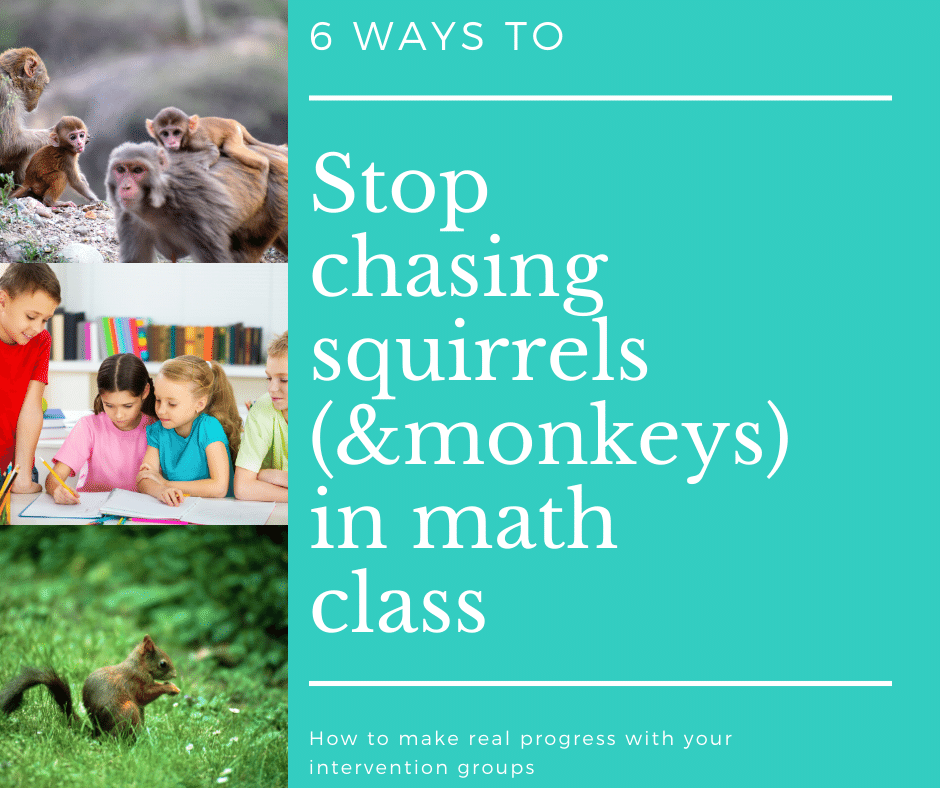
13 Jan Stop Chasing Monkeys- Keep the Focus
Are you running intervention groups?
Are you working with tier 1, 2, or tier 3 students? Of course, my guess is the answer is “ALL THREE.” What we know, is even if you are also supported by resource, intervention, or SpEd teachers (God bless those souls), YOU are also the interventionist.
Yes, I’ll say it louder for the people in the back: YOU ARE THE INTERVENTIONIST.
You are the teacher.
You are the re-teacher.
You are the frontloader.
You are the gap filler.
And you know what? We can do it. We can provide kids with what they need. We may not be able to do it for as long as they need each day. We may not even be able to run tiered instructional groups every day for math, but we CAN make a difference and not wait for our resource, interventionists, or SpEd teachers to save the day. We can’t wait until our school has funds to hire more support staff or until our grade level receives more intervention minutes. Our students can’t wait.
(A quick side note/disclaimer: There is A LOT we can do during our core instruction to support ALL students to be successful. Quality core instruction COMES FIRST. I’m not trying to label kids here– only suggest that students who have identified gaps need additional support in ADDITION to what they receive in Core….but more on that later.)
Although our support staff are very capable humans ( I was one for years), what I was most frustrated by was that I was seen as the hero. Any learning concerns a student had in mathematics became mine to fix. I was constantly bombarded by requests to add this student or that one. I was bombarded with, “Can you work on _____ with Johnny? Oh and he also needs…… oh and, and, and.” I needed this to be a partnership with the classroom teacher, after all, that child, those children, were/are OUR children.
What we know is that a 20-minute intervention group a few times a week isn’t going to fix every concern we have. But, partnered with intentional moves in the homeroom and in the intervention room, I think we can make a difference.
How?
I’m glad you asked.
STOP CHASING MONKEYS.
I used to say, and often still do, STOP CHASING squirrels. But then I had the lovely blessing to go to Barbadoes for a layover. Right outside our hotel, there were monkeys!! Real, live, hilarious monkeys and it reminded me of squirrels. Let me break it down.
You uncover that Sara doesn’t know how to count coin amounts. So, you pull her for a quick group on counting coins only to find out she doesn’t recognize the coins by name or by value yet.
SQUIRREL!!!
You start working on identifying coins. The next day, while in whole group, you realize Sara is not sure how to add two digits plus one-digit numbers.
SQUIRREL.
You start working on adding single-digit and two-digit numbers with Sara because she’s supposed to be adding two-digit by two-digit. You start to work on that in the small group you pull.
SQUIRREL!
You uncover the next day in the morning routines that Sara is not confident counting by tens and it appears she counts on her fingers to add ten more.
SQUIRREL!
Another small group, until you realize she counts by ones (or counts all ) for EVERY adding problem such as 8 + 3. She counts all 8 and then she counts all 3.
SQUIRREL.
Small group.
Squirrels, monkeys, whatever. The analogy is that as my husband and I were watching those monkeys outside our hotel, we kept interrupting each other:
“Look at that one…”
“NO, over there, he’s a new one….”
“I was looking at those two..LOOK! They are playing!”
“Look! There’s the mom!”
“Look! There’s two more over there.”
“Look! They’re chasing each other!”
Honestly, people. Trying to record those monkeys as like an act of God. They moved so quickly and as you tried to track one, another jumped into the mix. We couldn’t keep up and just found ourselves laughing at the chaos. Trying to chase squirrels is the same idea.
We are doing the same thing in our efforts to help our students with gaps. Each time we uncover something new, we change the focus of our small group. I’d like to suggest we all take a deep breath and KNOCK IT OFF.
It’s too much. It’s too much as an interventionist. It’s too much as a classroom teacher. We start chasing squirrels, we aren’t working together, and we aren’t even chasing the same goal every day.
Just stop.
Deep breath.
Try something new.
It is my suggestion that you first identify which role you are going to take and when you are going to take it.
Frontloader (Pre- teacher)
The frontloader is the person in charge of working on prerequisite skills that are interfering with the student’s ability to access the current content. This type of intervention is the ‘just in time’ intervention. You are frontloading coin identification and coin value because in two weeks you know students will begin counting by coins and using the coins in story problems. You are giving students the ‘just in time’ intervention so that he/she is more successful with the grade-level content coming. I know some teachers in 4th and 5th grade who will do this for the entire unit PRIOR to the unit they are frontloading. For example, if fractions are coming up in unit 4, then during unit 3, the teacher takes the role of the frontloader and works on basic fraction work from 3rd-4th grade so that students are more ready to access what’s coming in unit 4.
Re-teacher
The Re-teacher is more of the Tier 1/2 interventionist. This is when the teacher decides to follow the content. He/she might reteach at the end of each math block, at the end of a big idea (a series of lessons on a concept), and at the end of a unit (but not ONLY at the end of the unit– that’s not enough). The students that thrive with this are those who just need a double dose. They need more talking, more drawing, more modeling. They don’t need necessarily alternative ways or an intervention program. They just need to hear and see the content again. They need more time with the concept. These are the students just on the cusp of proficiency. A little boost and they’d be there.
Gap Filler
The Gap Filler’s role is for tier 2/3 students. This is when we can identify gaps in a student’s understanding. These gaps reveal more than a year below grade level’s understanding. They are a fourth grader but on a diagnostic, they scored at a 2nd-grade level. They are lacking significant skills or depth of understanding and need some off grade-level content and teaching. We are intentionally filling gaps. What we choose to focus upon may or may not have anything to do with the grade level’s current content. It is always lovely when it aligns, but it often does not. The gap filler often uses a diagnostic or screener assessment to dig deep and to really know what the student needs and what the priority needs may be. I am a fan of the Georgia Numeracy Project, who uses the IKAN and GLOSS assessment (free), as well as the Boulder Valley School District Number Screener. However, there are MANY tools out there and if you are currently using an intervention program such as Do the Math (one of my faves), it comes with its own pre-assessment. Do the Math was written by Marilyn Burns (Hi, Marilyn— MATH GIRL FAN HERE!) and she has a reasoning inventory that is also FANTASTIC.
Whatever role you choose, STICK WITH IT.
Stop chasing monkeys, squirrels, etc.
If only we were consistent and patient, I think we’d see so much more growth from students. We change what we are working on with them way too often and that leads us frustrated and downtrodden each time we give them an assessment and realize they have made little progress.
So, here’s how to make it work.
- Choose a role. Don’t change. Yep, you have students who need ALL THREE types of intervention. Bouncing around isn’t helping. Choose one and go. Maybe you are a re-teacher every day for 10 minutes at the end of class while students do independent work and then you become the gap filler during your WIN time (what I need) when other students might be pulled for other reasons or if that’s just when your school has allotted you intervention time. Don’t have intervention time? Well, complaining doesn’t help. Keep advocating for this time with school leadership but then GET ON WITH IT. Change starts with YOU. Create your own 30-minute block even if it is only 1 day a week and during your silent reading time.
If it matters, you’ll find a way, even if it is a small starfish on a large beach. If it doesn’t matter, you’ll find an excuse. Cheesy? Maybe, but in the starfish story, you know how it goes—
“IT MATTERED TO THAT ONE.”
2. Work WITH the support staff. Have any other support staff choose their role. Talk about it. Like really. As hard as it is, it is IMPERATIVE that we partner together. We should be using the same scaffolds, language, models, and methods. Our intervention pull out-groups are WAY too disconnected from our homeroom/core groups. Our most needy populations need the most consistency. They need us to be partners.
3. Pick 2-3 main goals no matter your role. If you were to look at your current unit or your current upcoming unit, what would you say are the MOST important skills all students at that grade should have? Pick those. If you are a pre teacher or re-teacher, those are what you are really focusing upon EVERY TIME YOU PULL THAT GROUP FOR INTERVENTION. You aren’t reteaching the objective of the day. You are instead choosing those 2-3 things (but maybe one at a time) and hammering away. You are providing scaffolds MORE visuals, MORE student talk, MORE conceptual teaching on these topics. Be careful!! This isn’t a walkthrough of their workbook. This is helping them to be successful with your 2-3 goals. This means they need to do the computations WITH the drawings, visuals, models, manipulatives.
If you are a gap filler, you choose 2-3 of the skills that showed up (maybe one at a time) on the diagnostic you administered. You are doing evidence-based interventions on those skills. Need help? I highly recommend using the scope and sequence of the IKAN or GLOSS to help identify needs and then use their follow up activities, or use a real intervention program. Honestly people. We wear too many hats. Although YOU might be this tier 3 interventionist, it doesn’t mean you don’t need support. Let’s stop shooting from the hip and guessing at what is effective. This is why curriculums are made. Use something systemic, systematic, and evidence-based. Or, ask me to help.
4. Collect Data.
I know, the dreaded four-letter word. But let’s face it. We need proof as well that something is working. Have proof what you are working on is needed. Set timelines for when you will re-assess (of course you should be jotting anecdotal notes every time you meet with students).
5. Stick with it. Be consistent. Even if you only have 1 30 minute block every Friday. Be consistent. Hold that 30-minute block no matter what else is going on. Most interventions last at least 6 weeks. If you are a re-teacher, you might cut this down depending on how much reteaching a skill needs. One of the things I learned as a math specialist/interventionist was I released students too soon. Students would show growth and I’d start working on something else. They needed the support a bit longer to really have it– not just have it for my little quiz. Our tier 2 kids especially are pretty tricky. Even if you don’t need 6 weeks, you shouldn’t move topics until you have EVIDENCE to support the move. Don’t chase monkeys.
6. CELEBRATE. Nothing is more defeating than working your tail off only to see the mountain you still have to climb. So, my friends, take time to celebrate every single success with these students. Shout from the mountain tops. Send me an email, I’ll shout with you. You don’t have to move the mountain today, but the mountain won’t move without small feats along the way. Celebrate. Be proud.
I hope these suggestions help to get you started. Start simple. Create the time you can do one of these roles. Approach it with a half glass full mindset. Don’t tell me you only have 10 minutes. I want you to have more too, but instead, say “YESSSSSS, I can pull this group every day for 10 minutes!!! WE can do this people! For 10 minutes we are going work so hard on ——- and I’m not giving up until we get there!!”
You can do this, friend.
GO BE GREAT. And…leave me a comment or send me an email. How has this challenged your thinking? In what ways is it making an impact?


Melissa Smith
Posted at 05:08h, 13 JanuaryI love this! I often feel like I’m chasing monkeys. Number 5 was really good for me to read. I have kids with so many gaps that I feel rushed to plug all the holes so I’m in a hurry to move on to the next hole.
Barb McMahon
Posted at 18:27h, 13 JanuaryI love the whole mindset behind this article. We will NEVER have all the time, material, curriculum, interventionists that we need. Buck up! Do your best and CELEBRATE!
Dawna Brandt
Posted at 21:46h, 13 JanuaryAwesome Article! Thank you for the links to some interesting math assessments I’ve never heard of. No, I never do have the time, but I’m willing to give it a try. Thank you for the encouragement!!